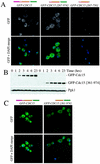Mitotic exit regulation through distinct domains within the protein kinase Cdc15
- PMID: 12832486
- PMCID: PMC162228
- DOI: 10.1128/MCB.23.14.5018-5030.2003
Mitotic exit regulation through distinct domains within the protein kinase Cdc15
Abstract
The mitotic exit network (MEN), a Ras-like signaling cascade, promotes the release of the protein phosphatase Cdc14 from the nucleolus and is essential for cells to exit from mitosis in Saccharomyces cerevisiae. We have characterized the functional domains of one of the MEN components, the protein kinase Cdc15, and investigated the role of these domains in mitotic exit. We show that a region adjacent to Cdc15's kinase domain is required for self-association and for binding to spindle pole bodies and that this domain is essential for CDC15 function. Furthermore, we find that overexpression of CDC15 lacking the C-terminal 224 amino acids results in hyperactivation of MEN and premature release of Cdc14 from the nucleolus, suggesting that this domain within Cdc15 functions to inhibit MEN signaling. Our findings indicate that multiple modes of MEN regulation occur through the protein kinase Cdc15.
Figures







Similar articles
-
Regulation of the mitotic exit protein kinases Cdc15 and Dbf2.Mol Biol Cell. 2001 Oct;12(10):2961-74. doi: 10.1091/mbc.12.10.2961. Mol Biol Cell. 2001. PMID: 11598184 Free PMC article.
-
Cdc15 integrates Tem1 GTPase-mediated spatial signals with Polo kinase-mediated temporal cues to activate mitotic exit.Genes Dev. 2011 Sep 15;25(18):1943-54. doi: 10.1101/gad.17257711. Genes Dev. 2011. PMID: 21937712 Free PMC article.
-
Asymmetric spindle pole localization of yeast Cdc15 kinase links mitotic exit and cytokinesis.Curr Biol. 2001 Mar 6;11(5):345-50. doi: 10.1016/s0960-9822(01)00095-1. Curr Biol. 2001. PMID: 11267871
-
Mitotic exit control: a space and time odyssey.Curr Biol. 2011 Oct 25;21(20):R857-9. doi: 10.1016/j.cub.2011.09.023. Curr Biol. 2011. PMID: 22032192 Review.
-
Coupling spindle position with mitotic exit in budding yeast: The multifaceted role of the small GTPase Tem1.Small GTPases. 2015 Oct 2;6(4):196-201. doi: 10.1080/21541248.2015.1109023. Small GTPases. 2015. PMID: 26507466 Free PMC article. Review.
Cited by
-
A noncanonical GTPase signaling mechanism controls exit from mitosis in budding yeast.bioRxiv [Preprint]. 2024 Jul 4:2024.05.16.594582. doi: 10.1101/2024.05.16.594582. bioRxiv. 2024. Update in: Proc Natl Acad Sci U S A. 2024 Nov 5;121(45):e2413873121. doi: 10.1073/pnas.2413873121. PMID: 38798491 Free PMC article. Updated. Preprint.
-
A noncanonical GTPase signaling mechanism controls exit from mitosis in budding yeast.Proc Natl Acad Sci U S A. 2024 Nov 5;121(45):e2413873121. doi: 10.1073/pnas.2413873121. Epub 2024 Oct 30. Proc Natl Acad Sci U S A. 2024. PMID: 39475649 Free PMC article.
-
The Mitotic Exit Network Regulates Spindle Pole Body Selection During Sporulation of Saccharomyces cerevisiae.Genetics. 2017 Jun;206(2):919-937. doi: 10.1534/genetics.116.194522. Epub 2017 Apr 26. Genetics. 2017. PMID: 28450458 Free PMC article.
-
Comparative polygenic analysis of maximal ethanol accumulation capacity and tolerance to high ethanol levels of cell proliferation in yeast.PLoS Genet. 2013 Jun;9(6):e1003548. doi: 10.1371/journal.pgen.1003548. Epub 2013 Jun 6. PLoS Genet. 2013. PMID: 23754966 Free PMC article.
-
Temporal control of the dephosphorylation of Cdk substrates by mitotic exit pathways in budding yeast.Proc Natl Acad Sci U S A. 2008 Oct 21;105(42):16177-82. doi: 10.1073/pnas.0808719105. Epub 2008 Oct 9. Proc Natl Acad Sci U S A. 2008. PMID: 18845678 Free PMC article.
References
-
- Bardin, A. J., and A. Amon. 2001. Men and sin: what's the difference? Nat. Rev. Mol. Cell Biol. 2:815-826. - PubMed
-
- Bardin, A. J., R. Visintin, and A. Amon. 2000. A mechanism for coupling exit from mitosis to partitioning of the nucleus. Cell 102:21-31. - PubMed
-
- Cenamor, R., J. Jimenez, V. J. Cid, C. Nombela, and M. Sanchez. 1999. The budding yeast Cdc15 localizes to the spindle pole body in a cell-cycle-dependent manner. Mol. Cell Biol. Res. Commun. 2:178-184. - PubMed
-
- Dan, I., N. M. Watanabe, and A. Kusumi. 2001. The Ste20 group kinases as regulators of MAP kinase cascades. Trends Cell Biol. 11:220-230. - PubMed
Publication types
MeSH terms
Substances
Grants and funding
LinkOut - more resources
Full Text Sources
Molecular Biology Databases
